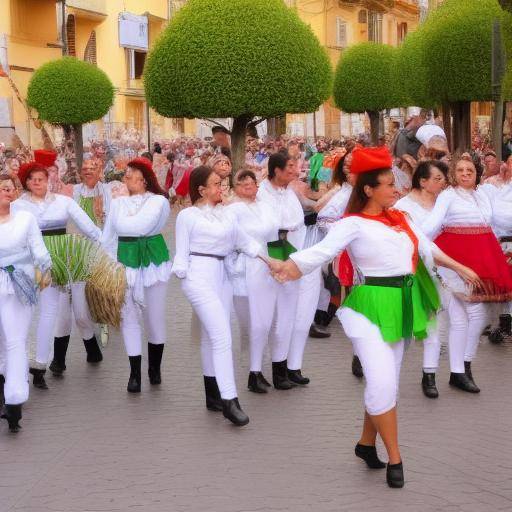
The Buñol Tomatina is one of the most emblematic events in Spain, attracting thousands of visitors from around the world to enjoy a unique experience full of fun and camaraderie. In this article, we will explore the history of the Tomatina, the traditions of Buñol and other Spanish festivals to give you a complete guide on how to enjoy these celebrations. From its historical origin to practical advice and future predictions, you will discover everything you need to know to immerse yourself in the madness and fun of the Tomatina of Buñol and other Spanish festivals.
Introduction
La Tomatina de Buñol is an annual event that takes place in the picturesque village of Buñol, in the province of Valencia, Spain. This festival, characterized by a tomato battle, attracts participants from all corners of the world who seek to immerse themselves in a unique experience full of joy, camaraderie and fun. Over the years, the Tomatina has evolved to become one of the most emblematic festivals in Spain, capturing the imagination of people of all ages and nationalities.
History and Background
The history of the Tomatina dates back to the 1940s, when a group of young people began a spontaneous food fight during local celebrations. Although tradition was interrupted on several occasions, it was finally established as an official event in the 1950s. Since then, the Tomatina has grown in popularity, attracting thousands of visitors every year and becoming an icon of Spanish culture.
The evolution of the Tomatina over the years has been remarkable, from being a local celebration to an international renowned event that attracts avid tourists to live a unique experience. In addition, the Tomatina has contributed significantly to the promotion of tourism in the region, consolidating its place as one of the most outstanding events in Spain.
Detailed Analysis
As the Tomatina has gained greater recognition worldwide, a number of benefits and challenges have emerged. On the one hand, the festival has generated a positive impact on the local economy, promoting tourism and creating employment opportunities in the region. However, the growing number of participants has raised challenges in terms of logistics and waste management.
A deeper analysis reveals that the Tomatina has triggered significant changes in the Buñol community. Local traditions have merged with the expectations of international visitors, creating a unique atmosphere that reflects diversity and inclusion. This phenomenon illustrates the capacity of cultural festivals to facilitate interaction between different cultures and foster mutual understanding.
Comprehensive review
In exploring the relevance of the Tomatina in the context of Spanish festivals, the opportunity arises to analyze best practices in organizing major events. Through comparisons with other regional festivals, effective strategies can be identified to manage key aspects such as security, sustainability and preservation of cultural identity.
Understanding the dynamics of the Tomatina also offers a valuable insight into the evolution of popular traditions in the contemporary context. As Spanish festivals adapt to the changing expectations of the public, it is essential to preserve the authenticity and cultural significance of these celebrations.
Comparative analysis
The comparison between Tomatina, Buñol and other Spanish festivals allows us to identify similarities and significant differences. While the Tomatina stands out for its playful and unravelled approach, other festivals can incorporate religious, historical or cultural elements that add complexity and diversity to Spain's public panorama. Recognizing these distinctions, participants have the opportunity to explore various experiences and enrich their understanding of Spain's rich festive tradition.
Practical Tips and Accessible Tips
To fully enjoy the Tomatina and other Spanish festivals, it is important to take into account a series of practical tips. From logistics preparation to active participation in the holidays, these tips provide valuable guidance to ensure a safe and rewarding experience. By following these recommendations, attendees can make the most of their participation in events, maximizing fun and minimizing possible setbacks.
Some tips include the choice of appropriate clothing, the management of transportation and accommodation logistics, as well as respect for local standards and traditions. These guidelines, based on the accumulated experience of organizers and participants, contribute to the creation of a harmonious and enriching festive environment for all those involved.
Industry Perspectives and Expert Reviews
The considerations about the impact of Tomatina and other Spanish festivals in the tourist and cultural industry are fundamental to understanding its scope and potential. Through the compilation of opinions and perspectives of experts in the field, a comprehensive picture of emerging trends and future opportunities can be obtained in the context of Spanish festivals. This expert vision provides a solid basis for strategic decision-making and policy design aimed at promoting and preserving these valuable cultural traditions.
Cases of Study and Applications of the Real World
Cases of study that reveal practical applications of the lessons learned from the Tomatina and other Spanish festivals are fundamental to illustrate how these events influence various spheres of society. Through the exploration of specific cases, we can identify patterns and lessons applicable to fields as diverse as event management, sustainable tourism, cultural marketing and the promotion of interculturalism.
These cases of study also provide tangible evidence of the impact of Tomatina and other Spanish festivals on the daily lives of local communities, demonstrating their ability to generate long-standing social, cultural and economic benefits.
Future Trends and Predictions
In considering the future of Tomatina, Buñol and the Spanish festivals as a whole, it is essential to reflect on emerging trends and possible evolutions. Given the dynamic nature of these events, it is crucial to anticipate and adapt to changes in demand, public preferences and socio-economic impact. Through the analysis of current data and the assessment of the perspectives of experts, it is possible to highlight the course that these festivals could take in the coming years, identifying opportunities for innovation and sustainable growth.
Conclusions
In short, the Tomatina de Buñol and other Spanish festivals represent a rich cultural tradition that has transcended borders and generated a significant impact at the local, national and international levels. In exploring its history, evolution, comparisons with other festive events, practical advice, industry perspectives, case studies and future predictions, this article has offered a comprehensive and insightful view of the importance of these holidays for Spain and the world.
Frequently asked questions
What's the story behind the Buñol Tomato?
The Buñol Tomatina has its roots in a spontaneous dispute between young people during the local holidays in the 1940s, which gradually evolved into an annual event of international renown.
How has Tomatina adapted over the years?
The Tomatina has evolved from being a local celebration to a large-scale event, attracting visitors from around the world and generating a positive impact on the local economy through tourism and the promotion of Spanish culture.
What are some best practices to enjoy the Tomatina and other Spanish festivals?
Some best practices include planning ahead in terms of accommodation and transportation, dressing properly for the occasion, respecting the rules of the event and participating in a conscious and respectful manner.
What is the impact of Tomatina on the economy and tourism of the Buñol region?
The Tomatina has generated a significant impact on the local economy, driving tourism and creating employment opportunities in the region. This event has contributed to positioning Buñol as an outstanding tourist destination.
What are some of the challenges associated with organizing events like the Tomatina?
Some of the associated challenges include logistics management for a large number of participants, security during the event, waste management and the preservation of the authenticity of the festival in the context of the growing influx of visitors.
Is there any significant social impact derived from the Tomatina and other Spanish festivals?
Yes, the Tomatina and other Spanish festivals have shown positive impacts in terms of cultural integration, the promotion of interculturalism and the generation of a sense of community both locally and internationally.
What are some emerging trends that could influence the evolution of Tomatina and other Spanish festivals?
Some emerging trends include a growing approach to environmental sustainability, the integration of technological tools to improve the experience of participants and the development of strategies to preserve the cultural authenticity of events.
In conclusion, the Tomatina de Buñol and other Spanish festivals represent an invaluable cultural heritage that has transcended borders and generated a significant impact on society. By understanding their history, evolution, challenges and future opportunities, spectators can fully appreciate the wealth and diversity of these festive events, contributing to their perpetuation and celebration.
With these perspectives in mind, as the next celebration of the Tomatina approaches, participants can prepare themselves to immerse themselves in the madness and fun of this iconic Spanish festival, celebrating the joy and the festive spirit that defines it. Let the fun begin!



